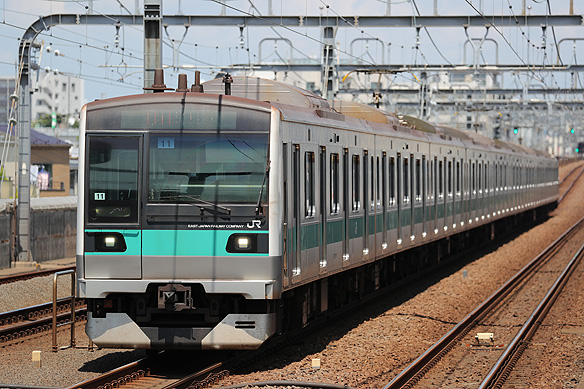Background and overview
JR East developed E233-2000 series commuter DC electric multiple unit (EMU) in 2003 to displace superannuated 203 series EMU and 207-900 series EMU used on Johban line and Tokyo Metro Chiyoda line interrunning services. 18 ten-car sets comprising 6 powered vehicles and 4 trailer vehicles were built over the period from May 2009 until September 2011 and delivered to Matsudo depot.
Car body
They have 2950mm wide body incorporating light weight stainless steel construction. Their floor level is 1130mm and 70mm lower than 203 series EMU to eliminate the level difference between platforms and the floor for accessibility. Bodies are unpainted and have the emerald-green waistline and headline bands running the length of each car below and above the windows. Cab ends having two clusters of a rectangular headlight applying sealed beam light bulb and a LED rectangular taillight below the windscreen are covered with a Fiber Reinforced Plastics (FRP) painted in silver and equipped with an emergency gangway swung outward located at co-driver's side. Anti-fall plates between vehicles are also introduced excepting the cab end. They are equipped with four 1300mm wide double-leaf automatic sliding doors, two drop windows between the doors excepting centre of the vehicles, and three fixed windows at the end and the centre on each side of the vehicle. Heat absorbent double-glazing glass is employed for all windows to improve noise and thermal insulation property and prevent their windows from dew condensation. The door operating equipments featuring electric liner motor drive, TKE152, is fitted above the door header of the sliding doors. Full-colour LED destination displays and loudspeakers, providing guidance broadcast for passengers waiting at a station, are fitted on each side of the body. An air conditioner, AU726A, rated at 50,000kcal/h is fitted on the centre of their roof. No ventilators are fitted on the roof.
Bogies
Powered bogies are DT71A, front trailer bogies of end vehicles are TR255,
and the other trailer bogies TR255A featuring bolster-less secondary air
suspension, trailing arm link journal box supporting system, and the single
link draw gear. They also prepare to be equipped with the yaw dampers to
ensure smooth ride characteristics even at 120km/h. Their bogie frame employs
bow-shape to lower the bolster suspension. Twin Disc (TD) flexible joint
employing deflecting plates made of carbon-fiber reinforced plastic (CFRP)
is applied for power transmission device. The gear ratio is 6.06. Motored
bogies employ single tread brake device adopting automatic gap-adjusting
unit and trailer bogies employ both double disk brake device and single
tread brake device adopting automatic gap-adjusting unit. TR255 also employs
a parking brake device.
Traction unit and ancillary equipments
Class mohaE233-2000/-2200/-2400 vehicles are equipped with a 2-step Variable-frequency drive (VFD) traction system, SC85B, which controls 8 traction motors, MT75, with a power output of 140kW on vehicle basis including class mohaE232-2000/-2200/-2400 vehicles. This traction system features Intelligent Power Module (IPM). Each traction system in a train set is connected with the bus line to prevent meltdown of the overhead lines at the section break. Class mohaE232-2000/-2400 powered intermediate vehicles are equipped with a duplex auxiliary power unit, SC91, with a power output of 260kVA featuring IGBT. Class mohaE232-2000/-2200/-2400 powered intermediate vehicles are equipped with a motor driven screw air compressor, MH3124-C1600SN3, under their floor. Class mohaE233-2000/-2200/-2400 powered intermediate vehicles are equipped with a single arm current pickup, PS33D. Class mohaE233-2000 vehicles are also equipped with a backup current pickup. They feature Train Information Management System (TIMS) applying RS485 rated at 10Mbps and managing the traction control, in-train announcement apparatus, voice communication for train crews and passengers, air conditioner control, and so on. They employ the electric commanding brake with regenerative braking. They feature total brake control on overall a train set and regenerative brake priority by TIMS to realize regeneration rate improvement. The end vehicles are equipped with ATC-10 and ATS-N signaling systems under the floor.
Accommodation
They consist of longitudinal bench seating featuring cantilever construction throughout having 450 mm wide per person. Each seat employs no sag springs supporting seat cushion and cantilever construction. E231 series and older EMU adopted baggage racks constructed by stainless steel pipes, whereas E233 series adopt baggage racks constructed by aluminum hollow plate having slits. Straps having black coloured longitudinal triangle shape are fitted throughout their body excepting priority seating area having orange coloured. A 17-inch LCD showing destination or stop information and a door chime are fitted on the door header of the sliding doors. Another LCD showing video ads prepares to be fitted next to the existing LCD. As for the device of driving cab, the control desk of the driver's cab is equipped with a one handle master controller operated by the left hand with dead man safety switch and three liquid crystal displays showing the speed meter, the pressure gauge, and the other information instead of analogue indicators.
Additional delivery
An additional 10-car set was built to displace 209-1000 series EMU used on Johban line and Tokyo metro Chiyoda line interrunning services.
Modifications
The signaling system for Odakyu Electric Railway, D-ATS-P, was additionally fitted over the period from August 2013 until December 2015. Another LCDs showing video ads was also fitted in 2015 additionally.
Operations
They entered Johban line and Tokyo metro Chiyoda line interrunning services in September 2009. They had completely displaced 209-1000 series EMU used on these services. They are now used on the Johban line, Tokyo metro Chiyoda line, and Odakyu Odawara line interrunning services. |
|

